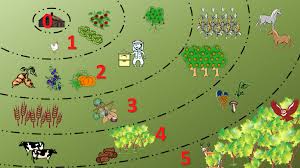The article “Permaculture: A Practical Introduction” discusses the 12 principles of permaculture and permaculture ethics. This article will show you how to apply them. If you would like to see the permaculture principles explained in detail, please refer back to the introductory article.
You can apply the 12 design principles of permaculture to your personal life, a business or a physical space. For now, let’s consider a physical site for permaculture gardening or farming. But don’t forget that these same tools can be used to apply permaculture principles to less concrete spaces as well.
The 12 Permaculture Principles in Action
Even though we are discussing plans for developing a physical space, permaculture is really about creating systems. Permaculture principles make it possible to design systems that run efficiently with little human intervention.
Going from permaculture principles to a permaculture farm requires three basic steps:
1: Observing and Analyzing the Site with Permaculture Principles in Mind
The first step to implementing permaculture principles requires patience and time. Each site is unique and changes throughout the year. Permaculture creator Bill Mollison recommends spending a full six months or longer in this phase so that each design element (garden, chicken coop, house, barn, well, pond, windbreak etc) is useful. If it is in the wrong spot it can’t work properly.
Here are some ways you can study your design site:
- Identify Characteristics of the Site – Study the topography, soil, water, vegetation, wildlife, climate and microclimates and infrastructure of your site. Document everything that is there.
- Consider the Human Requirements – Consider the goals and resources of the people who own and occupy the space.
- Study Energy Flow – Look for any energy flowing through the property. Which direction does the sunlight and wind come from? Is there traffic, pedestrian or otherwise on any part of the space?
- Analyze Inputs and Yields of Each Element – Consider each existing and proposed design element. This includes buildings, gardens, ponds, landscaping, etc. What does each element create or yield for the site? What resources will it use up? How much work will you have to put in to maintain it? This analysis will help you consider the relationships between all the existing and proposed elements in the system.
- Define Zones – Permaculture Zones are an easy way to apply permaculture principles to help place each design element. This will help you avoid mistakes like placing an herb spiral far from the kitchen or planting orchard trees close to the house.

Image courtesy of wikipedia.com
2: Create a Site Design
This part can be fun. Use your knowledge from step one and your understanding of permaculture principles to create drawings with the placement of different elements that you want on your site. It can be helpful to make several site plans in chronological order, since it is unlikely that you will implement the entire design at once.
3: Implement the Design
This is a gradual process of making permaculture principles come to physical fruition. Remember that changes in nature happen slowly, building upon one another. At your site you may begin with a single design element, adding more as time and resources allow.
Take a look at www.thechickentractor.com.au you may need something for your farm.
Extended Reading
Permaculture: A Practical Introduction
Permaculture Master Geoff Lawton shows permaculture principles in action at his property in New South Wales, Australia.

